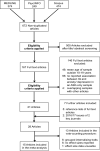IQ and Internalising Symptoms in Adolescents with ASD
- PMID: 33381856
- PMCID: PMC8510967
- DOI: 10.1007/s10803-020-04810-y
IQ and Internalising Symptoms in Adolescents with ASD
Abstract
Intelligence quotient (IQ), has been found to relate to the presence of internalising symptoms in autism spectrum disorder (ASD). This meta-analysis sought to clarify the direction of the relationship between IQ and two prevalent internalising symptoms, anxiety and depression, in adolescents with ASD. Secondly, this study aimed to highlight methodological factors contributing to inconsistent findings in existing research. Self-reported anxiety was found to be significantly higher in youth with a lower IQ, while depression was positively associated with IQ. Consequently, parents, schools and clinicians should be cautious of underestimating anxiety in youth with a lower IQ. However, care should also be taken to ensure adolescents with ASD without intellectual disabilities are not overlooked with regards to social and emotional support.
Keywords: Adolescents; Anxiety; Autism spectrum disorder; Depression; Intelligence quotient; Internalising symptoms.
© 2020. The Author(s).
Figures





Similar articles
-
Error-related brain activity and anxiety symptoms in youth with autism spectrum disorder.Autism Res. 2018 Feb;11(2):342-354. doi: 10.1002/aur.1898. Epub 2017 Dec 6. Autism Res. 2018. PMID: 29210194
-
[Impact of anxiety disorders on quality of life of adolescents with autism spectrum disorder without intellectual disability].Encephale. 2016 Dec;42(6):499-505. doi: 10.1016/j.encep.2015.12.025. Epub 2016 Nov 11. Encephale. 2016. PMID: 27842975 French.
-
Influence of parental education on the intelligence quotient profiles and socially adaptive behavior of school-age children with autism spectrum disorder in eastern China.J Zhejiang Univ Sci B. 2024 Feb 8;25(11):1009-1019. doi: 10.1631/jzus.B2300354. J Zhejiang Univ Sci B. 2024. PMID: 39626882 Free PMC article.
-
Assessment and Treatment of Anxiety in Youth With Autism Spectrum Disorders.Pediatrics. 2016 Feb;137 Suppl 2:S115-23. doi: 10.1542/peds.2015-2851J. Pediatrics. 2016. PMID: 26908467
-
The "Reading the Mind in the Eyes" Test in Autism-Spectrum Disorders Comparison with Healthy Controls: A Systematic Review and Meta-analysis.J Autism Dev Disord. 2019 Mar;49(3):1048-1061. doi: 10.1007/s10803-018-3814-4. J Autism Dev Disord. 2019. PMID: 30406435
Cited by
-
Evaluation of a "Picture Assisted Illustration Reinforcement" (PAIR) System for Oral Hygiene in Children with Autism: A Double-Blind Randomized Controlled Trial.Children (Basel). 2023 Feb 13;10(2):369. doi: 10.3390/children10020369. Children (Basel). 2023. PMID: 36832499 Free PMC article.
-
Autistic Characteristics, Cognitive Impairment, and Sex as Predictors of Anxiety and Depression among Autistic Youth.J Autism Dev Disord. 2024 Aug 2. doi: 10.1007/s10803-024-06406-2. Online ahead of print. J Autism Dev Disord. 2024. PMID: 39093544
-
Assessment and Treatment of Anxiety in Children with Autism Spectrum Disorder in School Settings: A Systematic Review and Meta-Analysis.School Ment Health. 2022;14(1):153-164. doi: 10.1007/s12310-021-09461-7. Epub 2021 Jun 18. School Ment Health. 2022. PMID: 34178161 Free PMC article.
-
Patterns of psychopathology and cognition in sex chromosome aneuploidy.J Neurodev Disord. 2021 Dec 15;13(1):61. doi: 10.1186/s11689-021-09407-9. J Neurodev Disord. 2021. PMID: 34911436 Free PMC article.
-
IQ trajectories in autistic children through preadolescence.JCPP Adv. 2023 Mar;3(1):e12127. doi: 10.1002/jcv2.12127. Epub 2023 Jan 31. JCPP Adv. 2023. PMID: 37397281 Free PMC article.
References
-
- American Psychiatric Association . Diagnostic and statistical manual of mental disorders. 5. Washington, DC: American Psychiatric Press; 2013. pp. 31–86.
Publication types
MeSH terms
LinkOut - more resources
Full Text Sources
Medical

